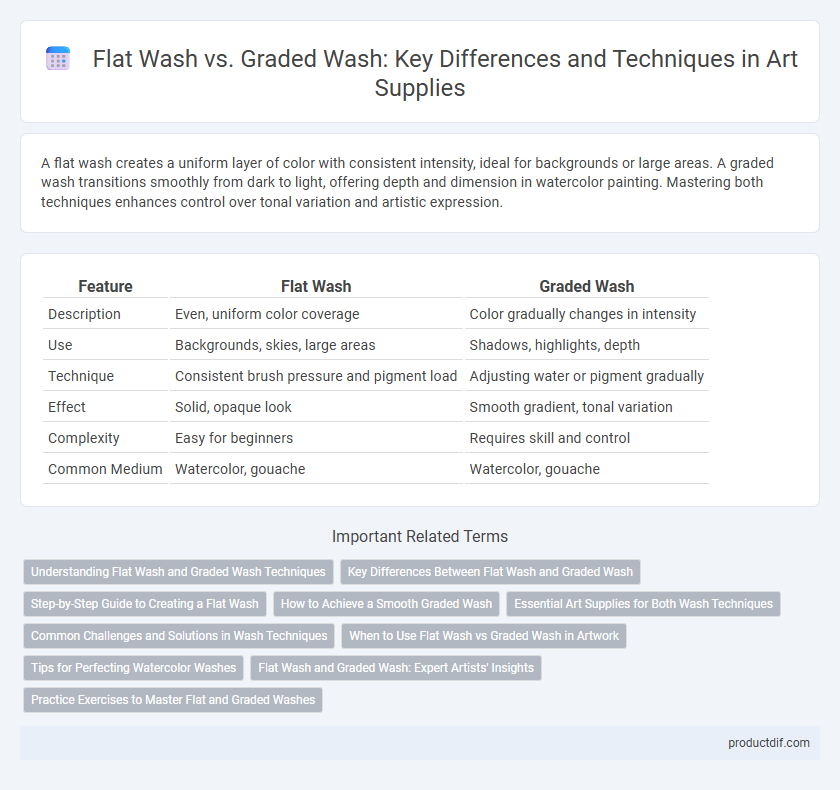A flat wash creates a uniform layer of color with consistent intensity, ideal for backgrounds or large areas. A graded wash transitions smoothly from dark to light, offering depth and dimension in watercolor painting. Mastering both techniques enhances control over tonal variation and artistic expression.
Table of Comparison
| Feature | Flat Wash | Graded Wash |
|---|---|---|
| Description | Even, uniform color coverage | Color gradually changes in intensity |
| Use | Backgrounds, skies, large areas | Shadows, highlights, depth |
| Technique | Consistent brush pressure and pigment load | Adjusting water or pigment gradually |
| Effect | Solid, opaque look | Smooth gradient, tonal variation |
| Complexity | Easy for beginners | Requires skill and control |
| Common Medium | Watercolor, gouache | Watercolor, gouache |
Understanding Flat Wash and Graded Wash Techniques
Flat wash and graded wash are fundamental watercolor techniques essential for creating different textures and visual effects in paintings. A flat wash provides an even, uniform layer of color across the paper, achieved by maintaining consistent pigment concentration and brush strokes. In contrast, a graded wash transitions smoothly from dark to light, requiring gradual dilution of pigment with water to create a seamless gradient.
Key Differences Between Flat Wash and Graded Wash
A flat wash features an even, uniform application of color with consistent saturation throughout the painted area, ideal for backgrounds or large color blocks in watercolor painting. In contrast, a graded wash gradually transitions from dark to light or from one color to another, creating a smooth gradient effect that emphasizes depth and dimension. The key differences lie in application technique and visual outcome: flat washes maintain a single tone, while graded washes showcase subtle changes in value or hue, enhancing composition dynamics.
Step-by-Step Guide to Creating a Flat Wash
A flat wash in watercolor painting involves applying an even, uniform layer of color across the entire surface, achieved by loading a brush with ample pigment and water before smoothly painting horizontally or vertically without lifting the brush. This technique requires consistent brush strokes and maintaining a wet edge to avoid streaks or uneven drying. Compared to a graded wash, where the pigment gradually fades, the flat wash emphasizes a solid, consistent tone ideal for backgrounds or large areas of color in art projects.
How to Achieve a Smooth Graded Wash
To achieve a smooth graded wash in watercolor painting, start with a clean, wet brush loaded with pigment and water, applying it evenly across the paper surface. Gradually dilute the pigment by adding more water to the brush as you move down the paper, maintaining consistent brush strokes to avoid streaks or hard edges. Using high-quality watercolor paper with a fine texture and a large flat brush helps control the pigment flow and blend colors seamlessly for a flawless gradient effect.
Essential Art Supplies for Both Wash Techniques
Essential art supplies for flat wash techniques include high-quality synthetic flat brushes, smooth watercolor paper, and a well-mixed palette of transparent watercolors for even color application. For graded washes, artists need round brushes with a fine tip, ample water for smooth gradient transitions, and absorbent watercolor paper that can handle multiple layers without buckling. Both techniques benefit from clean water containers and palette trays to maintain color purity and control fluidity.
Common Challenges and Solutions in Wash Techniques
Flat wash techniques often struggle with streaks and uneven pigment distribution, resulting in inconsistent color coverage. Graded wash challenges include managing smooth transitions without harsh lines or color breaks, especially when working on large surfaces. Using high-quality, evenly loaded brushes and practicing controlled brush strokes can effectively address these issues, ensuring a seamless and professional finish in watercolor or acrylic art applications.
When to Use Flat Wash vs Graded Wash in Artwork
Flat wash creates a uniform, consistent layer of color ideal for backgrounds or areas requiring even tone without variation. Graded wash transitions smoothly from dark to light, perfect for adding depth, dimension, or atmospheric effects in landscapes and skies. Artists choose flat wash to maintain simplicity and graded wash to suggest volume or light direction in their artwork.
Tips for Perfecting Watercolor Washes
Mastering watercolor washes requires understanding the differences between flat wash and graded wash techniques to achieve smooth, even color or gradual tonal transitions. Use a large, soft brush loaded with consistent pigment and ample water for flat washes to avoid streaks and maintain uniform coverage. For graded washes, tilt your paper and gradually dilute pigment with water, blending from dark to light seamlessly while maintaining a wet edge to prevent harsh lines.
Flat Wash and Graded Wash: Expert Artists' Insights
Flat wash and graded wash are essential watercolor techniques that expert artists use to achieve different visual effects in paintings. Flat wash provides an even, consistent layer of color, perfect for backgrounds and broad areas, while graded wash creates a gradual transition from dark to light, adding depth and dimension. Master painters emphasize mastering both washes to enhance texture, mood, and composition in their artwork.
Practice Exercises to Master Flat and Graded Washes
Practice exercises for mastering flat and graded washes include using a wide, flat brush to apply consistent, even strokes for flat washes, ensuring uniform color saturation across the paper. To perfect graded washes, artists should practice controlling water flow and pigment concentration, gradually reducing pigment intensity while maintaining smooth transitions. Repeated drills in varying brush angles and pressure help in developing precision and fluidity essential for professional-quality wash techniques.
Flat Wash vs Graded Wash Infographic

 productdif.com
productdif.com